中考英语语法难点汇总.doc
初中英语中考语法重点难点知识汇总
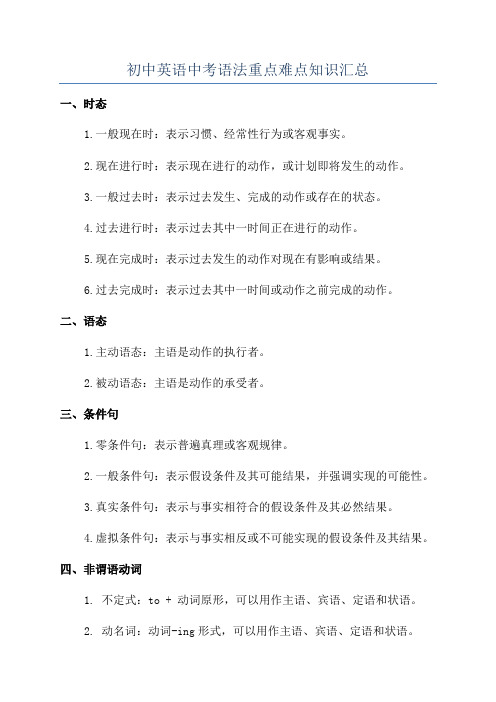
初中英语中考语法重点难点知识汇总一、时态1.一般现在时:表示习惯、经常性行为或客观事实。
2.现在进行时:表示现在进行的动作,或计划即将发生的动作。
3.一般过去时:表示过去发生、完成的动作或存在的状态。
4.过去进行时:表示过去其中一时间正在进行的动作。
5.现在完成时:表示过去发生的动作对现在有影响或结果。
6.过去完成时:表示过去其中一时间或动作之前完成的动作。
二、语态1.主动语态:主语是动作的执行者。
2.被动语态:主语是动作的承受者。
三、条件句1.零条件句:表示普遍真理或客观规律。
2.一般条件句:表示假设条件及其可能结果,并强调实现的可能性。
3.真实条件句:表示与事实相符合的假设条件及其必然结果。
4.虚拟条件句:表示与事实相反或不可能实现的假设条件及其结果。
四、非谓语动词1. 不定式:to + 动词原形,可以用作主语、宾语、定语和状语。
2. 动名词:动词-ing形式,可以用作主语、宾语、定语和状语。
3. 现在分词:动词-ing形式,可作定语、表语等。
4. 过去分词:-ed或不规则变化形式,常用作被动语态和完成时。
五、情态动词1. can/could:表示能力、许可、可能等。
2. may/might:表示允许、请求、可能、推测等。
3. must:表示推测、肯定、必需等。
4. should:表示义务、建议、推测、必要等。
六、名词1.可数名词与不可数名词及其用法。
2.名词所有格的表示方法。
七、代词1.人称代词:主格、宾格、物主代词、反身代词等。
2. 指示代词:this, that, these, those等。
3. 不定代词:some, any, no, every, all, both等。
八、形容词与副词1.形容词的比较级和最高级形式及其用法。
2.副词的比较级和最高级形式及其用法。
九、连词1. 并列连词:and, or, but等。
2. 从属连词:because, when, if, although等。
历年中考英语语法知识点难点总结
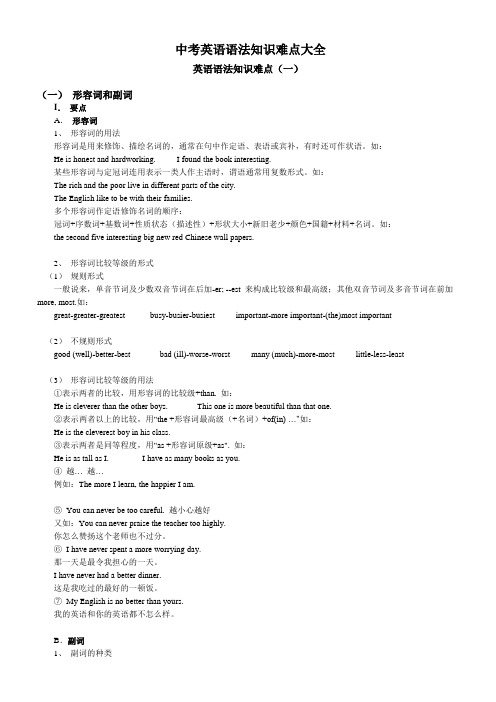
中考英语语法知识难点大全英语语法知识难点(一)(一)形容词和副词I.要点A.形容词1、形容词的用法形容词是用来修饰、描绘名词的,通常在句中作定语、表语或宾补,有时还可作状语。
如:He is honest and hardworking. I found the book interesting.某些形容词与定冠词连用表示一类人作主语时,谓语通常用复数形式。
如:The rich and the poor live in different parts of the city.The English like to be with their families.多个形容词作定语修饰名词的顺序:冠词+序数词+基数词+性质状态(描述性)+形状大小+新旧老少+颜色+国籍+材料+名词。
如:the second five interesting big new red Chinese wall papers.2、形容词比较等级的形式(1)规则形式一般说来,单音节词及少数双音节词在后加-er; --est 来构成比较级和最高级;其他双音节词及多音节词在前加more, most.如:great-greater-greatest busy-busier-busiest important-more important-(the)most important(2)不规则形式good (well)-better-best bad (ill)-worse-worst many (much)-more-most little-less-least(3)形容词比较等级的用法①表示两者的比较,用形容词的比较级+than. 如:He is cleverer than the other boys. This one is more beautiful than that one.②表示两者以上的比较,用"the +形容词最高级(+名词)+of(in) …"如:He is the cleverest boy in his class.③表示两者是同等程度,用"as +形容词原级+as". 如:He is as tall as I. I have as many books as you.④越… 越…例如:The more I learn, the happier I am.⑤You can never be too careful. 越小心越好又如:You can never praise the teacher too highly.你怎么赞扬这个老师也不过分。
中考英语语法知识难点大全TXT版

中考英语语法知识难点大全英语语法知识难点(一)??? 编稿:李俊和审稿:李俊和责编: 张晓俊(一)形容词和副词I.要点A.形容词1、形容词的用法形容词是用来修饰、描绘名词的,通常在句中作定语、表语或宾补,有时还可作状语。
如:He is honest and hardworking. I found the book interesting. 某些形容词与定冠词连用表示一类人作主语时,谓语通常用复数形式。
如:The rich and the poor live in different parts of the city. The English like to be with their families. 多个形容词作定语修饰名词的顺序:冠词+序数词+基数词+性质状态(描述性)+形状大小+新旧老少+颜色+国籍+材料+名词。
如:the second five interesting big new red Chinese wall papers. 2、形容词比较等级的形式(1)规则形式一般说来,单音节词及少数双音节词在后加-er; --est 来构成比较级和最高级;其他双音节词及多音节词在前加more, most.如:great-greater-greatest busy-busier-busiest important-more important-(the)most important (2)不规则形式good (well)-better-best bad (ill)-worse-worst many (much)-more-most little-less-least (3)形容词比较等级的用法①表示两者的比较,用形容词的比较级+than. 如:He is cleverer than the other boys. This one is more beautiful than that one. ②表示两者以上的比较,用"the +形容词最高级(+名词)+of(in) …"如:He is the cleverest boy in his class. ③表示两者是同等程度,用"as +形容词原级+as". 如:He is as tall as I. I have as many books as you. ④越…越…例如:The more I learn, the happier I am. ⑤ You can never be too careful. 越小心越好又如:You can never praise the teacher too highly. 你怎么赞扬这个老师也不过分。
历年中考英语语法知识点难点总结学生版
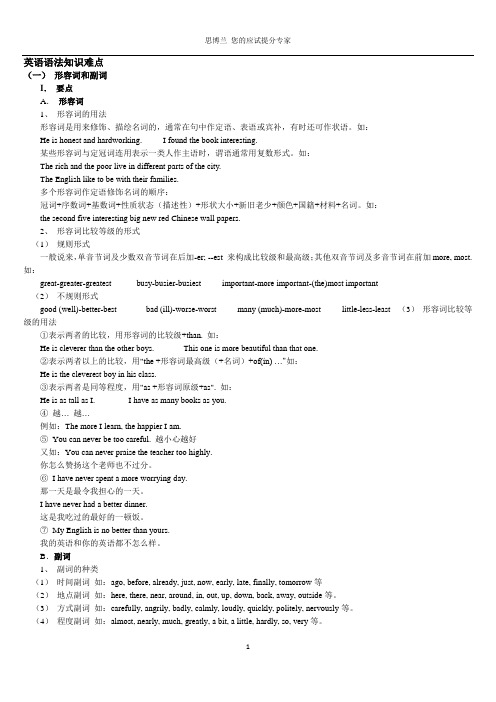
英语语法知识难点(一)形容词和副词I.要点A.形容词1、形容词的用法形容词是用来修饰、描绘名词的,通常在句中作定语、表语或宾补,有时还可作状语。
如:He is honest and hardworking. I found the book interesting.某些形容词与定冠词连用表示一类人作主语时,谓语通常用复数形式。
如:The rich and the poor live in different parts of the city.The English like to be with their families.多个形容词作定语修饰名词的顺序:冠词+序数词+基数词+性质状态(描述性)+形状大小+新旧老少+颜色+国籍+材料+名词。
如:the second five interesting big new red Chinese wall papers.2、形容词比较等级的形式(1)规则形式一般说来,单音节词及少数双音节词在后加-er; --est 来构成比较级和最高级;其他双音节词及多音节词在前加more, most.如:great-greater-greatest busy-busier-busiest important-more important-(the)most important (2)不规则形式good (well)-better-best bad (ill)-worse-worst many (much)-more-most little-less-least(3)形容词比较等级的用法①表示两者的比较,用形容词的比较级+than. 如:He is cleverer than the other boys. This one is more beautiful than that one.②表示两者以上的比较,用"the +形容词最高级(+名词)+of(in) …"如:He is the cleverest boy in his class.③表示两者是同等程度,用"as +形容词原级+as". 如:He is as tall as I. I have as many books as you.④越… 越…例如:The more I learn, the happier I am.⑤You can never be too careful. 越小心越好又如:You can never praise the teacher too highly.你怎么赞扬这个老师也不过分。
初中英语中考语法重点难点知识汇总

中考英语语法重点难点知识汇总一.英语语法重点与难点1、 as…as…结构:You’re a boy as good as Tom.=You’re as good a boy as Tom.你和汤姆是一样好的孩子。
2、 (1)too…to与 so…that sb. can’t…的句型转换:前者为简单句,主语只有一个,而后者为复合句,主语有两个,试比较:The man was too angry to be able to speak.The man was so angry that he wa sn’t able to speak.(2) too…to…与 not enough to句型的转换:He is too young to get married.=He is not old enough to get married.The book is too difficult for me to read.=The book is not easy enough for me to read.3、形容词原级表示比较级含义:约翰不象迈克那么苯。
John is not so stupid as Mike.John is less stupid than Mike.John is cleverer than Mike.4、用比较级表示最高级:约翰是班里最高的男生。
John is taller than any other boy in the class.John is the tallest boy in the class.5、 the more….. the more….表示“越……越……”:The more books you read, the wider your knowledge is.The more food you eat, the fatter you are.6、 more and more….表示“越来……越……”:More and more students realized the importance of a foreign language.Our country is getting stronger and stronger.二.中考考点—词组1. after, in 这两个介词都可以表示“……(时间)以后”的意思after 以过去为起点,表示过去一段时间之后,常用于过去时态的句子中如:She went after three days. 她是三天以后走的in 以现在为起点,表将来一段时间以后,常用于将来时态的句子中如:She will go in three days. 她三天以后要走2. how long, how often, how soonhow long指多长时间,主要用来对一段时间(如three days, four weeks 等)提问?如:How long ago was it? 这是多久前的事了?how often指每隔多久,主要用来对频率副词或状语(如once a week等)提问?如:—How often does he come here? —Once a month. 他(每隔)多久来一次?每月一次。
中考英语考试语法重点与难点

【导语】在初中阶段的英语学习中,⼤部分孩⼦英语出错都是因为语法问题。
由于语⽂的语法和英语的语法是完全不⼀样的,所以造就了很多孩⼦搞混淆了。
以下是整理的中考英语考试语法重点与难点,欢迎阅读!1.中考英语考试语法重点与难点 1、 as…as…结构:你和汤姆是⼀样好的孩⼦。
You’re a boy as good as Tom.You’re as good a boy as Tom. 2、 (1)too…to与 so…that sb. can’t…的句型转换:前者为简单句,主语只有⼀个,⽽后者为复合句,主语有两个,试⽐较: The man was too angry to be able to speak. The man was so angry that he wasn’t able to speak. (2) too…to…与 not enough to句型的转换: He is too young to get married.=He is not old enough to get married. The book is too difficult for me to read. The book is not easy enough for me to read. 3、形容词原级表⽰⽐较级含义: 约翰不象迈克那么苯。
John is not so stupid as Mike. John is less stupid than Mike. John is cleverer than Mike. 4、⽤⽐较级表⽰级:约翰是班⾥的男⽣。
John is taller than any other boy in the class. John is the tallest boy in the class.2.如何提升英语⼝语 ⼀、兴趣是可以培养的 做⼀件事,有兴趣总是会容易得多,快乐得多,甚⾄事半功倍。
中考语法重难点总结
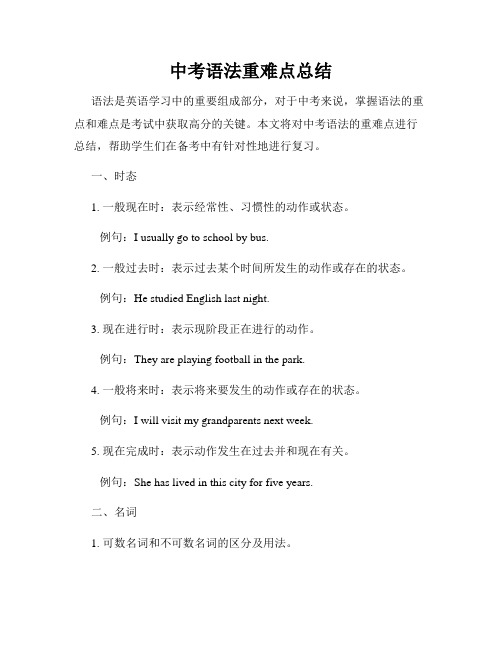
中考语法重难点总结语法是英语学习中的重要组成部分,对于中考来说,掌握语法的重点和难点是考试中获取高分的关键。
本文将对中考语法的重难点进行总结,帮助学生们在备考中有针对性地进行复习。
一、时态1. 一般现在时:表示经常性、习惯性的动作或状态。
例句:I usually go to school by bus.2. 一般过去时:表示过去某个时间所发生的动作或存在的状态。
例句:He studied English last night.3. 现在进行时:表示现阶段正在进行的动作。
例句:They are playing football in the park.4. 一般将来时:表示将来要发生的动作或存在的状态。
例句:I will visit my grandparents next week.5. 现在完成时:表示动作发生在过去并和现在有关。
例句:She has lived in this city for five years.二、名词1. 可数名词和不可数名词的区分及用法。
可数名词可用于单数和复数,可与数字连用;不可数名词不能与数字连用。
例句:I have three books. (可数名词)例句:I need some water. (不可数名词)2. 单数名词的复数形式及规则。
大多数单数名词加-s,以s、x、ch、sh结尾的加-es,以辅音字母+y结尾的变y为i加-es。
例句:I saw two dogs. (dog的复数形式)三、动词1. 动词的时态和语态。
动词的时态包括一般现在时、一般过去时、现在进行时、一般将来时、现在完成时等;语态包括主动语态和被动语态。
例句:They are watching a movie now. (现在进行时)例句:The book was written by him. (被动语态)2. 动词的非谓语形式:动词不定式、动名词和现在分词。
动词不定式以to开头,动名词以-ing结尾,现在分词以-ing结尾。
中考英语必考语法难点整理汇总(包含常见错误纠正)

中考英语必考语法难点整理汇总(包含常见错误纠正)一、动词时态与语态时态和语态的结合是语法学习中的重点和难点,尤其是在复杂句中应用时。
1. 动词时态难点:多种时态混用例句:By the time we got there, the train had already left.(到我们到达的时候,火车已经离开了。
)He has been working here since he graduated.(自从他毕业以来,他一直在这里工作。
)解析:强调完成和持续的动作时,常用完成时态。
2. 语态难点:被动语态的复杂结构例句:The project is being discussed by the team.(这个项目正在被团队讨论。
)The work should have been completed by now.(这项工作本应已经完成。
)解析:注意助动词搭配及时态的一致性。
二、非谓语动词1. 动名词与不定式难点:动词后接不定式或动名词的区别例句:I enjoy reading books in my free time.(我喜欢在空闲时间读书。
)He decided to leave early.(他决定早点离开。
)解析:动名词:多用于表示一般习惯或已经发生的事情。
不定式:多用于表达未来意图或计划。
2. 分词作状语难点:分词的逻辑主语问题例句:Having finished his homework, he went out to play.(完成作业后,他出去玩了。
)Seen from the top of the hill, the city looks beautiful.(从山顶上看,这座城市很美。
)解析:分词的逻辑主语需与主句的主语一致。
三、从句相关语法难点1. 定语从句中的关系词省略难点:何时可以省略关系词例句:The book (that) I borrowed is interesting.(我借的书很有趣。
中考英语语法知识点难点总结精选文档

中考英语语法知识点难点总结精选文档TTMS system office room 【TTMS16H-TTMS2A-TTMS8Q8-2016年中考英语语法知识难点大全英语语法知识难点(一)(一)形容词和副词I.要点A.形容词1、形容词的用法形容词是用来修饰、描绘名词的,通常在句中作定语、表语或宾补,有时还可作状语。
如:He is honest and hardworking. I found the book interesting.某些形容词与定冠词连用表示一类人作主语时,谓语通常用复数形式。
如:The rich and the poor live in different parts of the city.The English like to be with their families.多个形容词作定语修饰名词的顺序:冠词+序数词+基数词+性质状态(描述性)+形状大小+新旧老少+颜色+国籍+材料+名词。
如:the second five interesting big new red Chinese wall papers.2、形容词比较等级的形式(1)规则形式一般说来,单音节词及少数双音节词在后加-er; --est 来构成比较级和最高级;其他双音节词及多音节词在前加more, most.如:great-greater-greatest busy-busier-busiest important-more important-(the)most important(2)不规则形式good (well)-better-best bad (ill)-worse-worst many (much)-more-most little-less-least(3)形容词比较等级的用法①表示两者的比较,用形容词的比较级+than. 如:He is cleverer than the other boys. This one is more beautiful than that one.②表示两者以上的比较,用"the +形容词最高级(+名词)+of(in) …"如:He is the cleverest boy in his class.③表示两者是同等程度,用"as +形容词原级+as". 如:He is as tall as I. I have as many books as you.④越… 越…例如:The more I learn, the happier I am.⑤ You can never be too careful. 越小心越好又如:You can never praise the teacher too highly.你怎么赞扬这个老师也不过分。
历年中考英语语法知识点难点总结
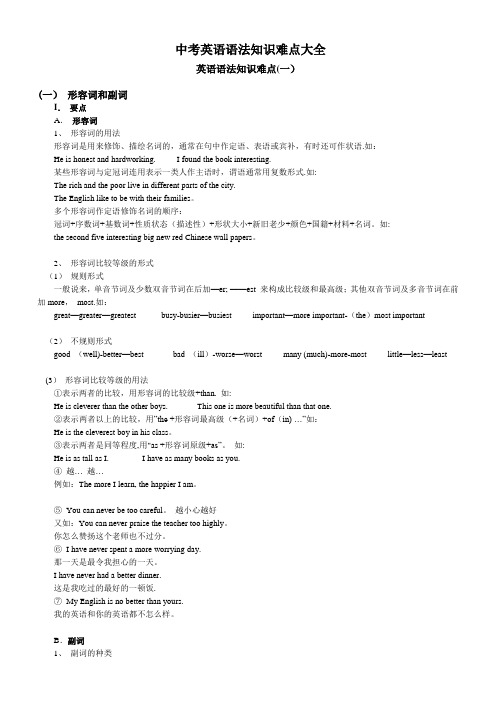
中考英语语法知识难点大全英语语法知识难点(一)(一)形容词和副词I.要点A.形容词1、形容词的用法形容词是用来修饰、描绘名词的,通常在句中作定语、表语或宾补,有时还可作状语.如:He is honest and hardworking. I found the book interesting.某些形容词与定冠词连用表示一类人作主语时,谓语通常用复数形式.如:The rich and the poor live in different parts of the city.The English like to be with their families。
多个形容词作定语修饰名词的顺序:冠词+序数词+基数词+性质状态(描述性)+形状大小+新旧老少+颜色+国籍+材料+名词。
如:the second five interesting big new red Chinese wall papers。
2、形容词比较等级的形式(1)规则形式一般说来,单音节词及少数双音节词在后加—er; ——est 来构成比较级和最高级;其他双音节词及多音节词在前加more,most.如:great—greater—greatest busy-busier—busiest important—more important-(the)most important(2)不规则形式good (well)-better—best bad (ill)-worse—worst many (much)-more-most little—less—least(3)形容词比较等级的用法①表示两者的比较,用形容词的比较级+than. 如:He is cleverer than the other boys. This one is more beautiful than that one.②表示两者以上的比较,用”the +形容词最高级(+名词)+of(in) …”如:He is the cleverest boy in his class。
【复习精华】中考英语语法知识难点讲解+例题解析
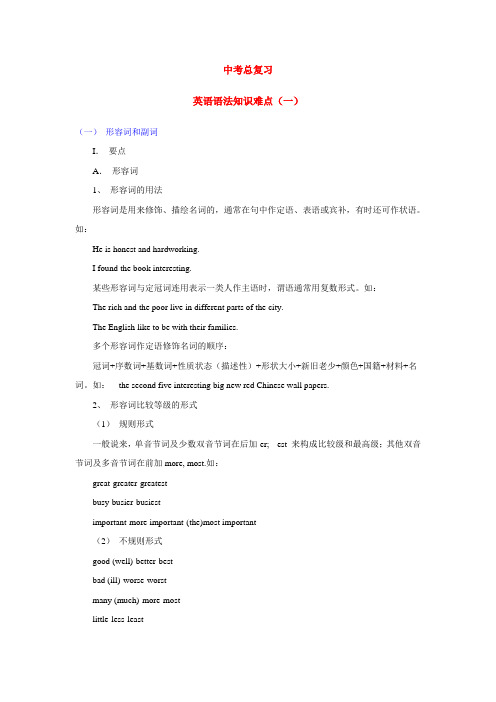
中考总复习英语语法知识难点(一)(一)形容词和副词I.要点A.形容词1、形容词的用法形容词是用来修饰、描绘名词的,通常在句中作定语、表语或宾补,有时还可作状语。
如:He is honest and hardworking.I found the book interesting.某些形容词与定冠词连用表示一类人作主语时,谓语通常用复数形式。
如:The rich and the poor live in different parts of the city.The English like to be with their families.多个形容词作定语修饰名词的顺序:冠词+序数词+基数词+性质状态(描述性)+形状大小+新旧老少+颜色+国籍+材料+名词。
如:the second five interesting big new red Chinese wall papers.2、形容词比较等级的形式(1)规则形式一般说来,单音节词及少数双音节词在后加-er; --est 来构成比较级和最高级;其他双音节词及多音节词在前加more, most.如:great-greater-greatestbusy-busier-busiestimportant-more important-(the)most important(2)不规则形式good (well)-better-bestbad (ill)-worse-worstmany (much)-more-mostlittle-less-least(3)形容词比较等级的用法①表示两者的比较,用形容词的比较级+than. 如:He is cleverer than the other boys.This one is more beautiful than that one.②表示两者以上的比较,用"the +形容词最高级(+名词)+of(in) …"如:He is the cleverest boy in his class.③表示两者是同等程度,用"as +形容词原级+as". 如:He is as tall as I.I have as many books as you.④越… 越…例如:The more I learn, the happier I am.⑤You can never be too careful. 越小心越好又如:You can never praise the teacher too highly.你怎么赞扬这个老师也不过分。
历年中考英语语法知识点难点总结

中考英语语法知识难点大全英语语法知识难点(一)(一)形容词和副词I.要点A.形容词1、形容词的用法形容词是用来修饰、描绘名词的,通常在句中作定语、表语或宾补,有时还可作状语。
如:He is honest and hardworking. I found the book interesting.某些形容词与定冠词连用表示一类人作主语时,谓语通常用复数形式。
如:The rich and the poor live in different parts of the city.The English like to be with their families.多个形容词作定语修饰名词的顺序:冠词+序数词+基数词+性质状态(描述性)+形状大小+新旧老少+颜色+国籍+材料+名词。
如:the second five interesting big new red Chinese wall papers.2、形容词比较等级的形式(1)规则形式一般说来,单音节词及少数双音节词在后加-er; --est 来构成比较级和最高级;其他双音节词及多音节词在前加more, most.如:great-greater-greatest busy-busier-busiest important-more important-(the)most important(2)不规则形式good (well)-better-best bad (ill)-worse-worst many (much)-more-most little-less-least(3)形容词比较等级的用法①表示两者的比较,用形容词的比较级+than. 如:He is cleverer than the other boys. This one is more beautiful than that one.②表示两者以上的比较,用"the +形容词最高级(+名词)+of(in) …"如:He is the cleverest boy in his class.③表示两者是同等程度,用"as +形容词原级+as". 如:He is as tall as I. I have as many books as you.④越… 越…例如:The more I learn, the happier I am.⑤You can never be too careful. 越小心越好又如:You can never praise the teacher too highly.你怎么赞扬这个老师也不过分。
历年中考英语语法知识点难点总结(K12教育文档)
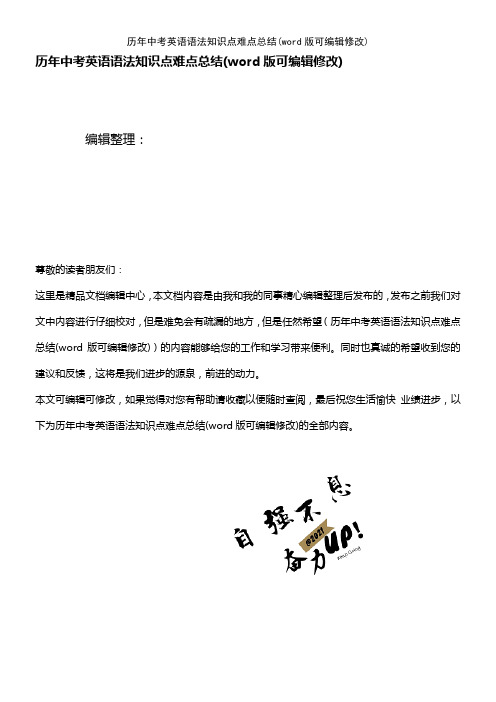
历年中考英语语法知识点难点总结(word版可编辑修改)编辑整理:尊敬的读者朋友们:这里是精品文档编辑中心,本文档内容是由我和我的同事精心编辑整理后发布的,发布之前我们对文中内容进行仔细校对,但是难免会有疏漏的地方,但是任然希望(历年中考英语语法知识点难点总结(word版可编辑修改))的内容能够给您的工作和学习带来便利。
同时也真诚的希望收到您的建议和反馈,这将是我们进步的源泉,前进的动力。
本文可编辑可修改,如果觉得对您有帮助请收藏以便随时查阅,最后祝您生活愉快业绩进步,以下为历年中考英语语法知识点难点总结(word版可编辑修改)的全部内容。
中考英语语法知识难点大全英语语法知识难点(一)(一) 形容词和副词I.要点A.形容词1、形容词的用法形容词是用来修饰、描绘名词的,通常在句中作定语、表语或宾补,有时还可作状语。
如:He is honest and hardworking.I found the book interesting。
某些形容词与定冠词连用表示一类人作主语时,谓语通常用复数形式.如:The rich and the poor live in different parts of the city.The English like to be with their families.多个形容词作定语修饰名词的顺序:冠词+序数词+基数词+性质状态(描述性)+形状大小+新旧老少+颜色+国籍+材料+名词。
如:the second five interesting big new red Chinese wall papers。
2、形容词比较等级的形式(1)规则形式一般说来,单音节词及少数双音节词在后加—er; --est 来构成比较级和最高级;其他双音节词及多音节词在前加more, most。
如:great-greater-greatestbusy-busier—busiestimportant-more important—(the)most important(2)不规则形式good (well)-better-bestbad (ill)—worse-worstmany (much)—more—mostlittle-less-least(3)形容词比较等级的用法①表示两者的比较,用形容词的比较级+than. 如:He is cleverer than the other boys。
历年中考英语语法知识点难点总结

中考英语语法知识难点大全英语语法知识难点(一)(一)形容词和副词I.要点A.形容词1、形容词的用法形容词是用来修饰、描绘名词的,通常在句中作定语、表语或宾补,有时还可作状语。
如:He is honest and hardworking.I found the book interesting.某些形容词与定冠词连用表示一类人作主语时,谓语通常用复数形式。
如:The rich and the poor live in different parts of the city.The English like to be with their families.多个形容词作定语修饰名词的顺序:冠词+序数词+基数词+性质状态(描述性)+形状大小+新旧老少+颜色+国籍+材料+名词。
如:the second five interesting big new red Chinese wall papers.2、形容词比较等级的形式(1)规则形式一般说来,单音节词及少数双音节词在后加-er; --est 来构成比较级和最高级;其他双音节词及多音节词在前加more, most.如:great-greater-greatestbusy-busier-busiestimportant-more important-(the)most important(2)不规则形式good (well)-better-bestbad (ill)-worse-worstmany (much)-more-mostlittle-less-least(3)形容词比较等级的用法①表示两者的比较,用形容词的比较级+than. 如:He is cleverer than the other boys.This one is more beautiful than that one.②表示两者以上的比较,用"the +形容词最高级(+名词)+of(in) …"如:He is the cleverest boy in his class.③表示两者是同等程度,用"as +形容词原级+as". 如:He is as tall as I.I have as many books as you.④越… 越…例如:The more I learn, the happier I am.⑤You can never be too careful. 越小心越好又如:You can never praise the teacher too highly.你怎么赞扬这个老师也不过分。
中考英语语法知识难点大全.doc
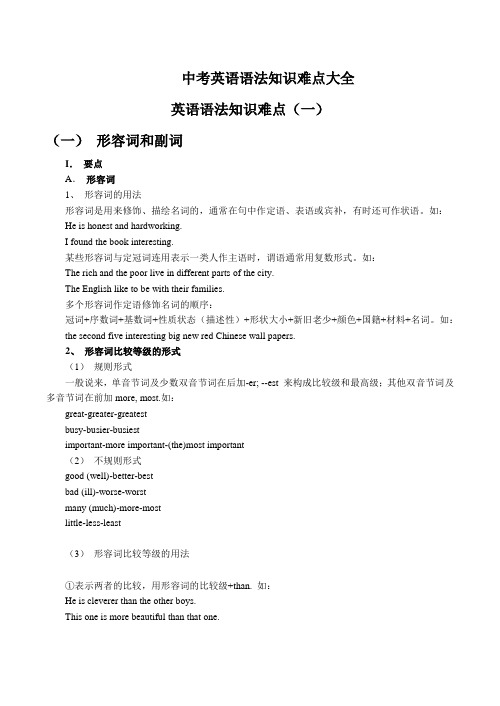
中考英语语法知识难点大全英语语法知识难点(一)(一)形容词和副词I.要点A.形容词1、形容词的用法形容词是用来修饰、描绘名词的,通常在句中作定语、表语或宾补,有时还可作状语。
如:He is honest and hardworking.I found the book interesting.某些形容词与定冠词连用表示一类人作主语时,谓语通常用复数形式。
如:The rich and the poor live in different parts of the city.The English like to be with their families.多个形容词作定语修饰名词的顺序:冠词+序数词+基数词+性质状态(描述性)+形状大小+新旧老少+颜色+国籍+材料+名词。
如:the second five interesting big new red Chinese wall papers.2、形容词比较等级的形式(1)规则形式一般说来,单音节词及少数双音节词在后加-er; --est 来构成比较级和最高级;其他双音节词及多音节词在前加more, most.如:great-greater-greatestbusy-busier-busiestimportant-more important-(the)most important(2)不规则形式good (well)-better-bestbad (ill)-worse-worstmany (much)-more-mostlittle-less-least(3)形容词比较等级的用法①表示两者的比较,用形容词的比较级+than. 如:He is cleverer than the other boys.This one is more beautiful than that one.②表示两者以上的比较,用"the +形容词最高级(+名词)+of(in) …"如:He is the cleverest boy in his class.③表示两者是同等程度,用"as +形容词原级+as". 如:He is as tall as I.I have as many books as you.④越… 越…例如:The more I learn, the happier I am.⑤You can never be too careful. 越小心越好又如:You can never praise the teacher too highly.你怎么赞扬这个老师也不过分。
英语中考语法知识难点
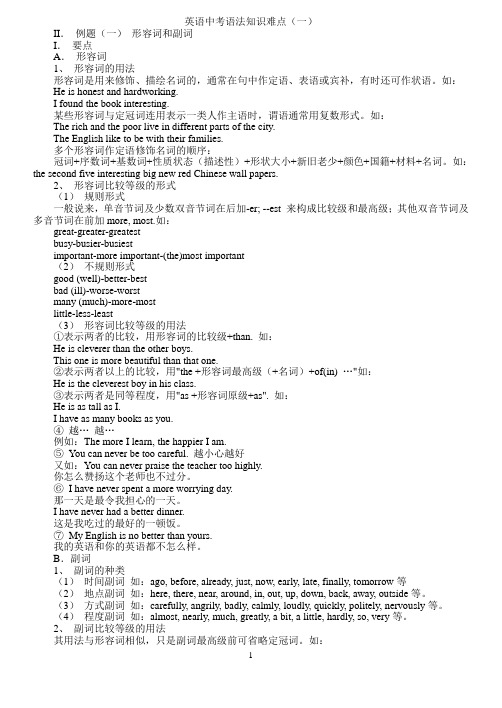
英语中考语法知识难点(一)II.例题(一)形容词和副词I.要点A.形容词1、形容词的用法形容词是用来修饰、描绘名词的,通常在句中作定语、表语或宾补,有时还可作状语。
如:He is honest and hardworking.I found the book interesting.某些形容词与定冠词连用表示一类人作主语时,谓语通常用复数形式。
如:The rich and the poor live in different parts of the city.The English like to be with their families.多个形容词作定语修饰名词的顺序:冠词+序数词+基数词+性质状态(描述性)+形状大小+新旧老少+颜色+国籍+材料+名词。
如:the second five interesting big new red Chinese wall papers.2、形容词比较等级的形式(1)规则形式一般说来,单音节词及少数双音节词在后加-er; --est 来构成比较级和最高级;其他双音节词及多音节词在前加more, most.如:great-greater-greatestbusy-busier-busiestimportant-more important-(the)most important(2)不规则形式good (well)-better-bestbad (ill)-worse-worstmany (much)-more-mostlittle-less-least(3)形容词比较等级的用法①表示两者的比较,用形容词的比较级+than. 如:He is cleverer than the other boys.This one is more beautiful than that one.②表示两者以上的比较,用"the +形容词最高级(+名词)+of(in) …"如:He is the cleverest boy in his class.③表示两者是同等程度,用"as +形容词原级+as". 如:He is as tall as I.I have as many books as you.④越…越…例如:The more I learn, the happier I am.⑤You can never be too careful. 越小心越好又如:You can never praise the teacher too highly.你怎么赞扬这个老师也不过分。
中考英语语法知识难点大全

中考英语语法知识难点大全【情态动词】情态动词与助动词I.要点助动词本身无意义,在句中帮助主要动词构成一定的时态,语态、语气,或是帮助构成否定句和疑问句,常用的助动词有be, do, have, shall(should), will(would).情态动词表一定的词义,本身并不表示动作或状态,而仅仅表达说话人的态度,它在句中须和主要动词一起构成谓语,主要的情态动词有can(could), may (might), must, have to, ought to, need, dare, shall, should, will, would.1、can 能,可以,表说话人同意,许可还可表客观条件许可,如:You can go now.提建议或请求时可用can I, can you表客气,如Can I buy you a drink? can和be able to表能力时的区别。
can表一般具有的能力,be able to表在特定条件下的能力,如:Although the driver was badly hurt, he was able to explain what had happened.2、may(1)、可以,表说话人同意,许可或请求对方许可。
You may go.(2)、(现在和将来)可能,也许,只用于肯定句和否定句中,如He may not be right.3、must, have tomust表主观上的必须,have to表客观上的必须,如:It's getting late.I have to go. -Must I go now. -Yes, you must.(No, you needn't./ No, you don't have to.)4、need, dare这二词有实意动词和情态动词两种词性,如用作实意动词后接动词不定式to do,如用作情态动词后接动词原形。
中考英语重难点汇总
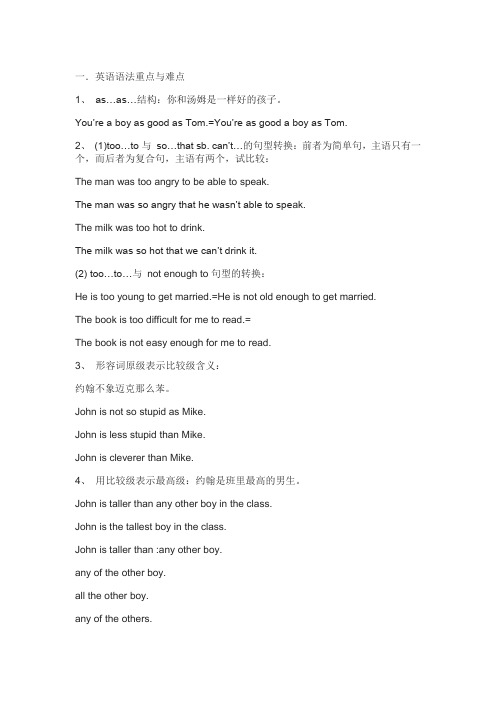
一.英语语法重点与难点1、as…as…结构:你和汤姆是一样好的孩子。
You’re a boy as good as Tom.=You’re as good a boy as Tom.2、(1)too…to与so…that sb. can’t…的句型转换:前者为简单句,主语只有一个,而后者为复合句,主语有两个,试比较:The man was too angry to be able to speak.The man was so angry that he wasn’t able to spe ak.The milk was too hot to drink.The milk was so hot that we can’t drink it.(2) too…to…与not enough to句型的转换:He is too young to get married.=He is not old enough to get married.The book is too difficult for me to read.=The book is not easy enough for me to read.3、形容词原级表示比较级含义:约翰不象迈克那么苯。
John is not so stupid as Mike.John is less stupid than Mike.John is cleverer than Mike.4、用比较级表示最高级:约翰是班里最高的男生。
John is taller than any other boy in the class.John is the tallest boy in the class.John is taller than :any other boy.any of the other boy.all the other boy.any of the others.any one else.5、the more….. the more….表示“越……越……”:The more books you read, the wider your knowledge is.The more food you eat, the fatter you are.6、more and more….表示“越来……越……”:More and more students realized the importance of a foreign language.Our country is getting stronger and stronger.Mid-Autumn FestivalMid-Autumn Day二.中考考点—词组初中阶段大致有150组词语辨析,近几年中考英语常考的有20组左右。
中考英语语法难点汇总精品文档10页
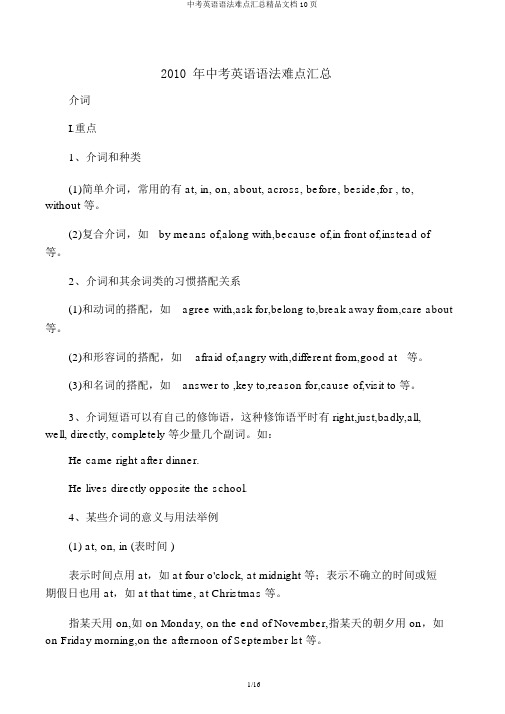
2010 年中考英语语法难点汇总介词I.重点1、介词和种类(1)简单介词,常用的有 at, in, on, about, across, before, beside,for , to, without 等。
(2)复合介词,如by means of,along with,because of,in front of,instead of 等。
2、介词和其余词类的习惯搭配关系(1)和动词的搭配,如agree with,ask for,belong to,break away from,care about 等。
(2)和形容词的搭配,如afraid of,angry with,different from,good at等。
(3)和名词的搭配,如answer to ,key to,reason for,cause of,visit to 等。
3、介词短语可以有自己的修饰语,这种修饰语平时有 right,just,badly,all, well, directly, completely 等少量几个副词。
如:He came right after dinner.He lives directly opposite the school.4、某些介词的意义与用法举例(1) at, on, in (表时间 )表示时间点用 at,如 at four o'clock, at midnight 等;表示不确立的时间或短期假日也用 at,如 at that time, at Christmas 等。
指某天用 on,如 on Monday, on the end of November,指某天的朝夕用 on,如on Friday morning,on the afternoon of September lst 等。
指于或短于一天的段用 in,如 in the afternoon, in February, in Summer, in 1999 等。
中考英语语法知识难点大全
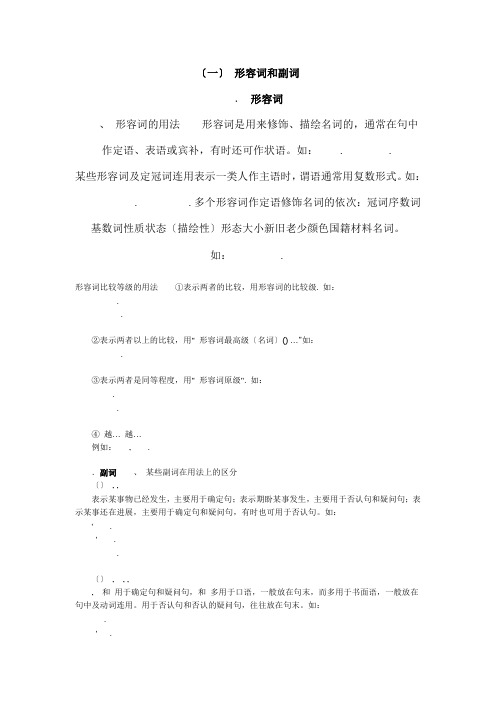
〔一〕形容词和副词.形容词、形容词的用法形容词是用来修饰、描绘名词的,通常在句中作定语、表语或宾补,有时还可作状语。
如: . .某些形容词及定冠词连用表示一类人作主语时,谓语通常用复数形式。
如: . .多个形容词作定语修饰名词的依次:冠词序数词基数词性质状态〔描绘性〕形态大小新旧老少颜色国籍材料名词。
如: .形容词比较等级的用法①表示两者的比较,用形容词的比较级. 如:..②表示两者以上的比较,用" 形容词最高级〔名词〕() …"如:.③表示两者是同等程度,用" 形容词原级". 如:..④越… 越…例如:, ..副词、某些副词在用法上的区分〔〕, ,表示某事物已经发生,主要用于确定句;表示期盼某事发生,主要用于否认句和疑问句;表示某事还在进展,主要用于确定句和疑问句,有时也可用于否认句。
如:' .' ..〔〕, , ,, 和用于确定句和疑问句,和多用于口语,一般放在句末,而多用于书面语,一般放在句中及动词连用。
用于否认句和否认的疑问句,往往放在句末。
如:.' ...() , 意为"几乎"及在词义上完全不同。
如:.() ,意为"最近、近来",意为"晚、迟"。
如:.?.例题例'解析:该题正确答案是。
修饰人高用, 而建筑物的高用,并且修饰形容词要放在形容词后面。
因此该题选。
例.解析:该题正确答案为。
"形容词比较级… , 形容词比较级…"意为越…,越…。
该句意为:吃的药越多,我的病越是加重。
例" ' "." ' ".解析:该题正确答案为。
和都用于确定句中。
本身意为否认"两者都不",而那么用于否认句中,意为"也"。
例.解析:该题正确答案为。
. 用于副词时,修饰详细的深,如,而那么修饰表示感情色调的词,如该题为.另如等。
- 1、下载文档前请自行甄别文档内容的完整性,平台不提供额外的编辑、内容补充、找答案等附加服务。
- 2、"仅部分预览"的文档,不可在线预览部分如存在完整性等问题,可反馈申请退款(可完整预览的文档不适用该条件!)。
- 3、如文档侵犯您的权益,请联系客服反馈,我们会尽快为您处理(人工客服工作时间:9:00-18:30)。
2019-2020 年中考英语语法难点汇总介词I. 要点1、介词和种类(1) 简单介词,常用的有 at, in, on, about, across, before, beside, for , to, without等。
(2) 复合介词,如 by means of, along with, because of, in front of, instead of等。
2、介词和其他词类的习惯搭配关系(1) 和动词的搭配,如 agree with, ask for, belong to, break away from, care about等。
(2) 和形容词的搭配,如 afraid of, angry with, different from, good at等。
(3) 和名词的搭配,如 answer to , key to, reason for, cause of, visit to等。
3、介词短语可以有自己的修饰语,这种修饰语通常有 right, just, badly, all, well, directly, completely 等少数几个副词。
如:He came right after dinner.He lives directly opposite the school. 4、 某些介词的意义与用法举例 (1) at, on, in ( 表时间 )表示时间点用 at ,如 at four o'clock, at midnight 等;表示不确定的时间或短期假日也 用 at ,如 at that time, at Christmas 等。
指某天用 on, 如 on Monday, on the end of November, 指某天的朝夕用 on ,如 onFriday morning, on the afternoon of September lst 等。
in ,如 in theafternoon, in February, in Summer, in 1999(2) between, among (表位置 )between 仅用于二者之间,但说三者或三者以上中的每两个之间的相互关系时,也用 between, 如I'm sitting between Tom and Alice. The village lies between three hills.among 用于三者或三者以上之间。
如: He is the best among the students. (3) beside, besidesbeside 意为 “在 旁边 ”,而 besides 意为 “除 之外 ”。
如: He sat beside me.What do you want besides this? (4) in the tree, on the treein the tree 指动物或人在树上,而 on the tree 指果实、树叶长在树上 (5) on the way, in the way, by the way, in this wayon the way 指在路上 in the way 指挡道 by the way 指顺便问一句 in this way 用这样的方法 (6) in the corner, at the cornerin the corner 指在拐角内 at the corner 指在拐角外 (7) in the morning, on the morningin the morning 是一般说法 on the morning 特指某一天的早晨(8) by bus, on the busby bus 是一般说法 on the bus 特指乘某一辆车 II. 例题例 1. Do you know any other foreign language ____ English?A. exceptB. butC. besideD. besides解析: A 、B 两项 except 等于 but ,意为 “除了 ”,C —beside 意为 “在 旁边 ”,不符合题意。
而 D —besides, 意为 “除了 之外,还有 ”。
所以该题正确答案为 D 。
该题意为:除指长于或短于一天的时段用等。
了英语外,你还知道别的语言吗?例2. He suddenly returned ____ a rainy night.A. onB. atC. inD. during解析:我们均知道,at night这一短语,但如果night 前有修饰词,表具体的夜晚,则要用介词on 来修饰,故该题正确答案为A。
例3. I'm looking forward ____ your letter.A. toB. inC. atD. on解析:该题正确答案为A。
look forward to为固定搭配,意为“期望、盼望”。
连词I.要点1、连词的种类or, (1)并列连词用来连接并列关系的词、短语或分句,如and, for, or, both and, eitherneither nor等。
(2)从属连词用来引导从句,如that, if, whether, when, after, as soon as 等。
除了从属连词 (引导状语从句 ) 外,还有其它可以用来引导从句的词类。
它们是连接代词和连接副词 (引导名词性从句 ),关系代词和关系副词 ( 引导定语从句 )。
2、常用连词举例(1)and 和,并且(2)bothand和,既也(3)but 但是,而(4)either或or或,要么要么Either you're wrong, or I am.(5) for因为I asked him to stay, for I had something to tell him.(6) however然而,可是Af first, he didn't want to go there. Later, however, he decided to go.(7) neither既nor不也不Neither my parents nor my aunt agrees with you.(8) not only but (also)不但而且He not only sings well, but also dances well.(9) or或者,否则Hurry up, or you'll be late.Are you a worker or a doctor?(10) so因此,所以It's getting late, so I must go.(11) although虽然Although it was late, they went on working.(12) as soon as一就I'll tell him as soon as I see him.(13) because因为He didn't go to school, because he was ill.(14) unless除非,如果不I won't go unless it is fine tomorrow.(15) until直到He didn't leave until eleven. (瞬间动词用于not until结构 )He stayed there until eleven.(16) while当时候,而( 表示对比 )While I stayed there, I met a friend of mine. (while后不可用瞬间动词)My pen is red while his is blue.(17) for因为He was ill, for he didn't come. (结论是推断出来的(18)s ince自从I have lived here since my uncle left.(19) hardly when一就I had hardly got to the station when the train left.(20) as far as就来说As far as I know, that country is very small.You may walk as far as the lake. (一直走到湖那里) )II.例题例1. John plays football ____, if not better than, David.A. as wellB. as well asC. so wellD. so well as解析:该题意为:John踢足球如果不比David好的话,那也踢得和David 一样好。
一样好为as well as.故该题正确答案为 B.和例2. She thought I was talking about her daughter, ____, in fact, I was talking about mydaughter.A. whenB. whereC. whichD. while解析:该处意为“然而”,只有while有此意思,故选D。
例3. Would you like a cup of coffee ____ shall we get down to business right away?A. andB. thenC. orD. otherwise解析:该处意为“或者”,正确答案为C。
动词时态、语态I.要点1、一般现在时(1)表示经常发生的动作或现在存在的状态,常与sometimes, always, often, every day时间状语连用。
如:Sometimes, we go swimming after school.(2)表示客观真理、科学事实等。
如:The earth goes round the sun.2、现在进行时(1)表示说话时或现阶段正在进行的动作,常与now, at present等时间状语连用。
如:等What are you doing now?(2)和 always, continually 等连用,表一种经常反复的动作,常含有某种情感。
如:He is always doing good deeds.3、现在完成时主要表示动作发生在过去,对现在仍有影响,或动作一直延续到现在,或可能还要继续下去,常与 just, already, so far, once, never等词连用。
如:Have you ever been to Beijing?4、一般将来时表示将来某一时间要发生的动作或存在的状态,常与tomorrow, next year等连用。
